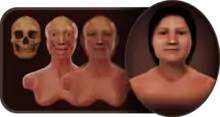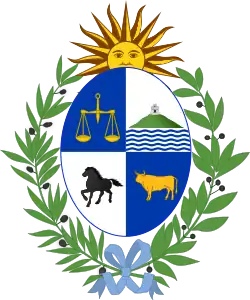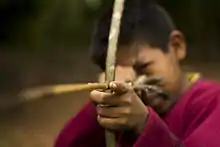Indigenous peoples in Uruguay
Indigenous peoples in Uruguay or Native Uruguayans, are the peoples who have historically lived in the modern state of Uruguay. Because of colonial practices, disease and active exclusion, only a very small share of the population is aware of the country's indigenous history or has known indigenous ancestry.[3][4]



| This article is part of a series on the |
| Culture of Uruguay |
|---|
 |
|
Uruguay Portal |
Scholars disagree agree about the first settlers in what is now Uruguay, but there is evidence of human presence from 10,000 BCE. Indigenous Uruguayans disappeared in the 1830s and, with the exception of the Guaraní, little is known about these peoples and even less about their genetic characteristics.[5] The Charrúa peoples were perhaps the best-known indigenous people of the Southern Cone in what was called the Banda Oriental.[6] Other significant tribes were the Minuane, Yaro, Güenoa, Chaná, Bohán, and the Arachán. Languages once spoken in the area include Charrúa, Chaná, Güenoa, and Guaraní.
A 2005 genetic study showed 38% of Uruguayans had some indigenous ancestry.[7][8] In the 2011 Census, 4.9% of the population reported having indigenous ancestry.[4] A 2004 DNA study in the American Journal of Human Biology suggested that the Native American contribution to Uruguay's genetic composition may be far higher than is commonly assumed.[9]
History
In pre-colonial times, Uruguayan territory was inhabited by small tribes of nomadic Charrúa, Chana, Arachan and Guarani peoples. They were semi-nomadic people who survived by hunting, fishing and gathering and probably never numbered more than 10,000 – 20,000 people.[10] It is estimated that there were about 9,000 Charrúa and 6,000 Chaná and Guaraní at the time of contact with the Spanish in the 1500s. By the time of independence, some 300 years later, there were only about 500 native people remaining in Uruguay. The decline in the native population was due to disease, intermarriage, and persecution. With little immunity to diseases brought by European settlers, native peoples and culture were gradually diminished.
The genocide of the Charrúa culminated on April 11, 1831 with the Massacre of Salsipuedes, where most of the Charrúa men were killed by the Uruguayan army on the orders of President Fructuoso Rivera. The remaining 300 Charrua women and children were divided as household slaves and servants among Europeans. By 1840 there were only 18 surviving Charrua in Uruguay.[11] According to the history professor and journalist Lincoln Maiztegui Casas, “the disappearance of the Charrúa people was a gradual process that took more than 200 years, and the root cause was territorial occupation by Europeans”.[12]
Significant peoples
Charrúa
The Charrúa were an indigenous people or Indigenous Nation of the Southern Cone in present-day Uruguay[13] and the adjacent areas in Argentina (Entre Ríos) and Brazil (Rio Grande do Sul).[14][15] They were a semi-nomadic people who sustained themselves mainly through hunting and gathering. Since resources were not permanent in every region, they would constantly be on the move.[16] Rain, drought, and other environmental factors determined their movement. For this reason they are often classified as seasonal nomads.[16]
The Charrúa people were massacred in a campaign in 1831 by the colonial forces in Uruguay known as the Massacre of Salsipuedes. Though largely erased from modern histories, some communities of the Charrúa survived outside of Uruguay in Argentina and Brazil. It is believed that there are approximately between 160,000 and 300,000 individuals in Uruguay, Argentina, and Brazil today who are descendants of surviving Charrúa.[17] Contemporary descendants of the Charrúa have created organizations and advocate for the memory of the indigenous people.Guarani
Guarani is a group of culturally-related indigenous peoples of South America. They are distinguished from the related Tupi by their use of the Guarani language. The traditional range of the Guarani people is in what is now Paraguay between the Paraná River and lower Paraguay River, the Misiones Province of Argentina, southern Brazil once as far east as Rio de Janeiro, and parts of Uruguay and Bolivia.[18]
Although their demographic dominance of the region has been reduced by European colonisation and the commensurate rise of mestizos, there are contemporary Guarani populations in Paraguay and parts of Argentina and Bolivia. Most notably, the Guarani language, still widely spoken across traditional Guarani homelands, is one of the two official languages in Paraguay, the other one being Spanish.[19] The Paraguayan population learns Guarani both informally from social interaction and formally in public schools. In modern Spanish, Guarani also refers to any Paraguayan national in the same way that the French are sometimes called Gauls.See also
References
- Moraes, Cícero. "A "Avó" dos Uruguaios" (in Portuguese). Archived from the original on 20 January 2019. Retrieved 20 January 2019.
- "Reconstrucción 3D de Cráneo prehistórico del Uruguay". Portal de Museos del Uruguay (in Spanish). Ministry of Education and Culture (Uruguay). Archived from the original on 20 January 2019. Retrieved 20 January 2019.
- "South America :: Uruguay — The World Factbook - Central Intelligence Agency". www.cia.gov.
- "Atlas Sociodemografico y de la Desigualdad en Uruguay, 2011: Ancestry" (PDF) (in Spanish). National Institute of Statistics. Archived from the original (PDF) on 2014-11-13.
- Sans, Monica; Figueiro, Gonzalo; Sanguinetti, Carlos; Echarte-Rafaelli, Lourdes; Portela, Cecilia; Taranto, Luis; Pizzarossa, Carlos; Oliver, Roberto; Manikowski, Rosana; Barreto, Isabel; Hidalgo, Pedro; Berro, Guido. "The last Charrua Indian; (Uruguay): analysis of the remains of Chief Vaimaca Per". Nature Precedings – via www.academia.edu.
- Burford, Tim (2011). The Bradt Travel Guide Uruguay. Bucks, UK: Bradt Travel Guides. ISBN 978-1-84162-316-0.
- Da Silva Villarrubia, Santiago Katriel (14 July 2011). "Dra. Sinthia Pagano. Un Estudio Detectó 38% de Sangre Aborigen en la Población Uruguaya - En Uruguay hay 115.118 descendientes de indígenas". Mario Delgado Gérez (in Spanish). LaRed21 Comunidad. Retrieved 6 February 2013.
- Da Silva Villarrubia, Santiago Katriel (27 August 2011). "Censo 2011. Organizaciones Sociales Llaman a Decir "Sí" Para Reconocer sus Etnias - Censo: afrodescendientes e indígenas hacen campaña". Matías Rotulo (in Spanish). LaRed21 Comunidad. Retrieved 6 February 2013.
- Bonilla, Carolina (2004). "Substantial native American female contribution to the population of Tacuarembó, Uruguay, reveals past episodes of sex-biased gene flow". American Journal of Human Biology. 16 (3): 289–297. doi:10.1002/ajhb.20025. PMID 15101054. S2CID 34341356.
- Gibbon, S.; Santos, R.; Sans, Mónica (November 15, 2011). Racial Identities, Genetic Ancestry, and Health in South America: Argentina, Brazil, Colombia, and Uruguay. Springer. ISBN 9781137001702 – via Google Books.
- Jermyn, Leslie (August 18, 1999). Uruguay. Marshall Cavendish. ISBN 9780761408734 – via Google Books.
- "Uruguay and the memory of the Charrúa tribe – ThePrisma.co.uk". Archived from the original on 2017-10-08. Retrieved 2018-05-17.
- Renzo Pi Hugarte. "Aboriginal blood in Uruguay" (in Spanish). Raíces Uruguay. Retrieved 2 February 2015.
- Burford 2011, p. 16.
- Alayón, Wilfredo (28 March 2011). "Uruguay and the memory of the Charrúa tribe". The Prisma. Retrieved 20 Dec 2011.
- Acosta y Lara, Eduardo, F. El Pais Charrua. Fundacion BankBoston, 2002.
- Alayón, Wilfredo (28 March 2011). "Uruguay and the memory of the Charrúa tribe". The Prisma. Retrieved 20 Dec 2011.
- "Society-Guarani". Archived from the original on 2006-09-25.
- "Paraguay". Embassy of Paraguay in the United States of America. Archived from the original on 2009-01-19.
- Renzo Pi Hugarte. "Aboriginal blood in Uruguay". Raíces Uruguay. Retrieved 2 February 2015. (in Spanish)
- Keane, Augustus Henry. Central and South America, Volume 1. London: Edward Stanford, 1901.
- "Bohanes, Guenoas and Yaros". Escuela Digital. Retrieved 2 February 2015. (in Spanish)
- "El origen de los charrúas". EL PAIS. Retrieved November 6, 2015. (in Spanish)
External links
- Renzo Pi Hugarte (1969). "El Uruguay indígena" (PDF). Nuestra Tierra. Retrieved 12 May 2015. (in Spanish)

.svg.png.webp)